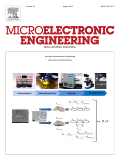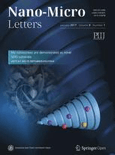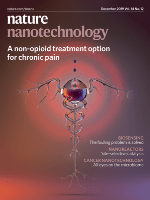
Microfluidics and Nanofluidics
Scope & Guideline
Bridging Science and Application in Microfluidics
Introduction
Aims and Scopes
- Microfluidic Device Design and Fabrication:
Research includes methodologies for designing and fabricating microfluidic devices using various materials and techniques, such as 3D printing, soft lithography, and paper-based systems. - Biomedical Applications:
The journal frequently publishes studies on the application of microfluidics in biomedical fields, including drug delivery, cancer diagnostics, and cell culture systems. - Fluid Dynamics and Transport Phenomena:
A core focus on understanding fluid dynamics, including electrokinetics, thermal management, and multiphase flow characteristics within micro and nanoscale systems. - Integration of Machine Learning and AI:
Emerging research often combines microfluidic systems with machine learning and AI for optimizations in design, monitoring, and real-time data analysis. - Nanotechnology and Materials Science:
Papers often explore the synthesis and application of nanomaterials within microfluidic systems, enhancing performance for various applications including sensing and drug delivery. - Environmental and Analytical Chemistry:
The journal also addresses environmental applications, such as water quality assessment and pollutant detection, utilizing microfluidic platforms for rapid analysis.
Trending and Emerging
- Point-of-Care Diagnostics:
A growing number of publications focus on developing microfluidic devices for rapid, on-site diagnostics, particularly in response to global health challenges like the COVID-19 pandemic. - 3D Printing and Additive Manufacturing:
Research increasingly highlights the use of 3D printing technologies for creating complex microfluidic devices that are customizable and cost-effective. - Integration of Sensing Technologies:
Emerging studies are focusing on integrating sensing technologies into microfluidic platforms, enhancing their capabilities for real-time monitoring and analysis. - Biomimetic and Organ-on-a-Chip Systems:
There is a notable trend towards developing biomimetic systems and organ-on-a-chip models that replicate human physiological conditions for drug testing and disease modeling. - Sustainability and Green Chemistry:
An increasing number of papers emphasize sustainable practices in microfluidic applications, focusing on environmentally friendly materials and processes.
Declining or Waning
- Traditional Microfabrication Techniques:
There is a noticeable shift away from conventional microfabrication methods, such as photolithography, towards more innovative and cost-effective approaches like 3D printing and soft lithography. - Basic Fluid Mechanics Studies:
Research focusing solely on fundamental fluid mechanics without application to specific microfluidic systems is becoming less prevalent, as the journal emphasizes practical applications. - Low-Complexity Systems:
The trend is moving away from simpler microfluidic systems towards more complex and integrated devices that offer multifunctional capabilities and enhanced performance.
Similar Journals

Frontiers of Physics
Elevating Physics Knowledge to New HeightsFrontiers of Physics, published by Higher Education Press, is a premier open-access journal dedicated to fostering innovative research and excellence within the field of physics. With an ISSN of 2095-0462 and an E-ISSN of 2095-0470, this rapidly growing journal has established itself as a valuable platform for disseminating cutting-edge findings, covering a diverse range of topics from theoretical frameworks to experimental advancements. Notably, Frontiers of Physics has achieved an impressive Q1 ranking in the 2023 Scopus Quartiles for Physics and Astronomy, securing a competitive 5th out of 81 positions in its category, reflecting a high impact factor that underscores its importance to the scientific community. Since its inception in 2011 and continuing through 2024, the journal aims to bridge the gap between academia and industry, encouraging collaboration among researchers, professionals, and students alike. Its commitment to open access ensures that high-quality research is readily accessible, thereby promoting knowledge sharing and advancement in the global physics community. Explore the potential of your research in Frontiers of Physics, where the future of physics flourishes.

MICROELECTRONIC ENGINEERING
Transforming Ideas into Breakthroughs in Microelectronic TechnologiesMICROELECTRONIC ENGINEERING is an esteemed journal published by Elsevier, focusing on the rapidly evolving fields of microelectronics and nanotechnology. It encompasses a wide array of topics, including atomic and molecular physics, condensed matter physics, and the engineering aspects of electronic, optical, and magnetic materials. With its impressive impact factor and recognition as a Q2 journal in several categories, it provides an invaluable platform for researchers and professionals to disseminate their groundbreaking findings. The journal has been instrumental in advancing our understanding and application of microelectronic technologies since its inception in 1983. Currently ranked highly within various specialized categories in Scopus, MICROELECTRONIC ENGINEERING offers targeted access to cutting-edge research, fostering innovation and collaboration in the world of electronic engineering and materials science. As we look towards the future, with convergence continuing to shape research until 2024, the journal remains a critical resource for those dedicated to pushing the boundaries of knowledge in these dynamic fields.

Nanotechnology and Precision Engineering
Catalyzing innovation through open access scholarship.Nanotechnology and Precision Engineering is a leading open access journal published by AIP Publishing, dedicated to advancing the fields of nanotechnology and precision engineering. Established in 2006, the journal has become a vital resource for researchers, professionals, and students, reflecting the latest advancements in Electrical and Electronic Engineering, Industrial and Manufacturing Engineering, Instrumentation, Mechanical Engineering, and Nanoscience. With an impressive variety of quartile rankings in Scopus—notably Q1 in several key engineering domains—the journal provides a robust platform for disseminating groundbreaking research. Noteworthy aspects include its open access format introduced in 2018, ensuring that high-quality research is freely accessible to a global audience. By maintaining a commitment to excellence and collaboration, Nanotechnology and Precision Engineering plays a crucial role in shaping the future of technology and innovation.

Nanoscience and Technology-An International Journal
Exploring the Frontiers of Nanoscience and TechnologyNanoscience and Technology-An International Journal, published by BEGELL HOUSE INC, is a leading platform dedicated to the rapidly evolving fields of nanoscience and nanotechnology. With its ISSN 2572-4258 and E-ISSN 2572-4266, the journal serves as a crucial resource for researchers, professionals, and students alike, focusing on advanced materials, condensed matter physics, and mechanics of materials. It holds a commendable position in the scholarly community, evidenced by its Q2 ranking in 2023 across multiple categories including Condensed Matter Physics and Materials Science. The journal aims to disseminate high-quality research, promote interdisciplinary collaboration, and facilitate innovation within the nano realm. With its convergence period from 2019 to 2024, it continues to attract a diverse array of studies and insightful contributions, reinforcing its importance in shaping the future of nanotechnology and its applications.

Nano-Micro Letters
Connecting researchers to breakthrough discoveries in nanotechnology.Nano-Micro Letters is a premier open-access journal published by Shanghai Jiao Tong University Press, specializing in groundbreaking research in the fields of Electrical and Electronic Engineering, Nanoscience, and Materials Science. Launched in 2009, this journal has rapidly established its reputation, achieving Q1 ranking across various categories, including Electronic, Optical and Magnetic Materials, and Surfaces, Coatings and Films, indicating its significant impact within the academic community. With an impressive Scopus ranking of #5 out of 797 in Electrical and Electronic Engineering and #2 in Surfaces, Coatings and Films, Nano-Micro Letters serves as a vital platform for disseminating cutting-edge insights and innovations in nanotechnology. Researchers, professionals, and students are encouraged to engage with the open-access content, fostering a collaborative environment that promotes the advancement of knowledge in these dynamic fields.

Journal of Physics-Materials
Igniting Innovation through Open Access ResearchJournal of Physics-Materials, published by IOP Publishing Ltd, serves as a leading platform for disseminating groundbreaking research in the realms of Atomic and Molecular Physics, Condensed Matter Physics, and Materials Science. This Open Access journal, established in 2018, enables wide-reaching visibility and accessibility to high-impact studies, fostering international collaboration and innovation within the scientific community. With a remarkable Q1 ranking in prestigious categories and impressive Scopus rankings—positioned at #38 in Condensed Matter Physics and #29 in Atomic and Molecular Physics—this journal plays a pivotal role in shaping contemporary research and discussions in physics and materials science. Researchers, students, and professionals alike are encouraged to contribute to and engage with the rich knowledge base this journal offers, which is dedicated to advancing the frontier of materials research and its numerous applications.

Micro and Nanostructures
Advancing the Frontiers of Material ScienceMicro and Nanostructures is a leading academic journal published by Academic Press Ltd - Elsevier Science Ltd, focusing on the cutting-edge fields of biomaterials, condensed matter physics, and electronic, optical, and magnetic materials. With an impact factor reflecting its rising status, the journal has achieved remarkable rankings within its categories, including Q2 in Condensed Matter Physics and Electronic, Optical and Magnetic Materials, and Q3 in Biomaterials, as of 2023. Spanning from 2022 to 2024, Micro and Nanostructures presents integral research that advances the understanding and application of micro- and nanostructured materials, thereby playing a crucial role for researchers, professionals, and students alike. As an open access publication, it ensures broad accessibility to groundbreaking studies that shape the future of material science. The journal's commitment to high-quality research and its strategic positioning as a premier source of knowledge in its domain make it an essential platform for the dissemination of innovative ideas and discoveries.

Journal of Physical Chemistry Letters
Pioneering Discoveries in Physical and Theoretical ChemistryThe Journal of Physical Chemistry Letters, published by the American Chemical Society, is a premier journal in the fields of Physical and Theoretical Chemistry, Materials Science, and Nanoscience and Nanotechnology. Since its inception in 2010, this journal has established itself as a significant platform for rapid publications of cutting-edge research that bridges various branches of chemistry, providing a critical avenue for advancing knowledge in these dynamic fields. With an impressive impact factor and a consistent ranking in the top quartile (Q1) of its categories, the journal ranks 25th out of 189 in Physical and Theoretical Chemistry and 79th out of 463 in General Materials Science according to Scopus metrics. Although it currently does not operate under an open access model, it remains an essential resource for academics seeking to disseminate their findings to a global audience. Researchers, professionals, and students alike will find invaluable insights and contributions that push the boundaries of scientific inquiry within these disciplines.

Nature Nanotechnology
Exploring the Boundaries of Nanotechnology Research.Nature Nanotechnology, published by NATURE PORTFOLIO, stands at the forefront of scientific innovation, focusing on the rapidly evolving field of nanoscience and nanotechnology. With an impressive impact factor and ranking in the top Q1 quartiles across multiple disciplines—including Atomic and Molecular Physics, Bioengineering, and Materials Science—this journal is a pivotal resource for researchers and professionals dedicated to advancing knowledge and applications at the nanoscale. Its diverse scope encompasses cutting-edge research that bridges disciplines, addressing critical challenges in engineering, physics, and biomedical fields. Although the journal currently does not offer an open-access option, readers can access a wealth of information that is vital for anyone involved in pioneering research and development efforts. With its robust editorial standards and a commitment to publishing high-caliber, groundbreaking work, Nature Nanotechnology serves as an indispensable platform for the dissemination of transformative ideas that will shape the future of technology and science.

BioChip Journal
Catalyzing Breakthroughs in Biomedical Engineering and BeyondBioChip Journal, published by the Korean Biochip Society (KBCS), is a renowned academic platform dedicated to advancing the fields of bioengineering, biomedical engineering, biotechnology, and electrical and electronic engineering. With its ISSN 1976-0280 and E-ISSN 2092-7843, this esteemed journal has established itself as a valuable resource for researchers, professionals, and students alike, providing them with cutting-edge research and insights since its inception in 2008. The journal has earned a commendable standing in the academic community, achieving Q2 ranking across key categories, thereby placing it amongst the top-tier publications. With its impressive Scopus rankings, including a top 10% position in Electrical and Electronic Engineering and a strong showing in both Biomedical Engineering and Biotechnology, BioChip Journal plays a vital role in disseminating innovative biochip technologies and applications. The journal continues to invite groundbreaking studies and reviews that promote the interdisciplinary collaboration essential for the future of biochip research, ultimately contributing to advancements in healthcare, diagnostics, and therapeutics.